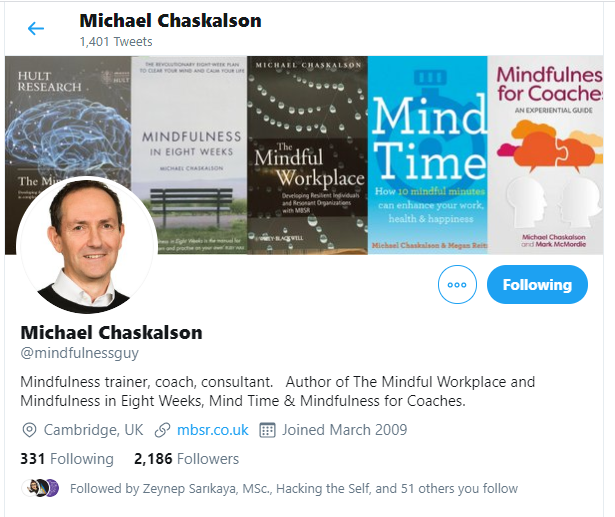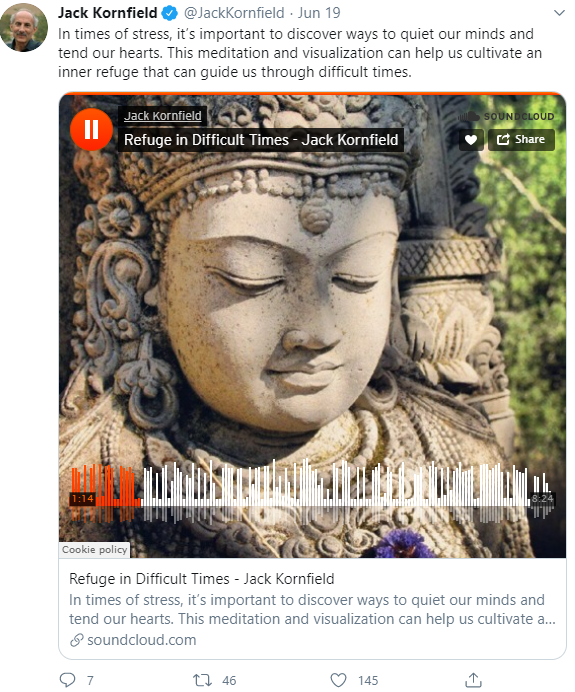This is the final (seventh) session from a One-day Meditation Program for Children and Teenagers with guidance from Ven. Olande Ananda #OlandeAnanda via @TheHappyRajSaga @MindcultureGuru

This is the final (seventh) session from a One-day Meditation Program for Children and Teenagers with guidance from Ven. Olande Ananda #OlandeAnanda via @TheHappyRajSaga @MindcultureGuru

This is the sixth session from a One-day Meditation Program for Children and Teenagers with guidance from Ven. Olande Ananda #OlandeAnanda via @TheHappyRajSaga @MindcultureGuru
Have you heard this:
Yesterday is history, tomorrow is a mystery, today is a gift… which is why we call it the present.
That is exactly why being in the moment matters. That is called mindfulness.
Here are eight accounts on Twitter you must follow if you are serious about being mindful. All of them help you become a better you, in their own ways.
Everyday Mindfulness says that the journey is the destination. And 243,000 followers are on board with that idea.





Charles G. Hanna is the author of Higher: Awaken to a More Fulfilling Life, who focuses on #Mindfulness #Meditation #Addiction #Recovery
You can count on him to share things like this:


Michael Chaskalson’s Twitter feed is not that popular, but it is a hidden gem. A mindfulness trainer, coach, consultant, he is the author of The Mindful Workplace and Mindfulness in Eight Weeks, Mind Time & Mindfulness for Coaches.
You can count on him to follow various media and share the best with you.

Again, take a deep breath!
Wishing you a happy and mindful week and month ahead.
Photo by Daria Shevtsova from Pexels
Photo by Tobias Bjørkli from Pexels

Leaves dance to the rhythm of the rain, while tree limbs sway and I realize,
something within me enjoys the wildness of the storm, thunder rolls and boils in the sky, yet I’m not afraid, instead…amazed how creation nourishes the earth, as the rain becomes gentle again.
via Storm Meditation — Ancient Skies
Photo by Allan Scott McMillan from Pexels
This is the fifth session from a One-day Meditation Program for Children and Teenagers with guidance from Ven. Olande Ananda #OlandeAnanda via @TheHappyRajSaga @MindcultureGuru
Don’t take my word for it. Follow Buddha’s advice and follow “…after observation and analysis, when you find that anything agrees with reason and is conducive to the good and benefit of one and all, then accept it and live up to it.”
Where to begin?
Here’s one of the latest Tweet I found. They are more or less in the same vein.
Here’s what @DalaiLama shared before his birthday about his ‘science guru’ David Bohm. @BohmSociety
This only goes to say that Buddhism isn’t a religion, because it appeals to rational thinking rather than anything else. And seems @DalaiLama agrees. That is why his Twitter account is so popular. Its always positive, rational and uplifting, regardless of your religion.
@Buddhism_Now
Buddhism Now is an online Buddhist magazine based upon the teachings of the Buddha, published from Totnes, England that is followed by over 189,000 people.
Check this out. Heres what it looks like

@LionsRoar
“Lion’s Roar is Foundation is a mission-driven, reader-supported publisher of Buddhist teachings, news, and perspectives.” Here’s the type of thing you will find on their Twitter feed that is followed by over 83,000 people.
@tricyclemag
Tricycle Magazine is a Buddhist Review of teachings, wisdom, and critique where you can sign up for Daily Dharma newsletter.
@FindInnerPeace Buddhist Mediation
on Twitter is a no frills, no visuals account that offers you much food for thought and wisdom.
There are thousands more places you can go to. But these are some of the more reliable sources I turn to.
And of course you can follow us
@TheHappyRajSaga
https://twitter.com/TheHappyRajSaga/status/1284158257674715142

 Meditating Into Happiness is the seventh novel in The Happy Raj Saga Series by Nihal S. Dissanayake. This book will be serialized in the MeditatingIntoHappiness Blog from today.
Meditating Into Happiness is the seventh novel in The Happy Raj Saga Series by Nihal S. Dissanayake. This book will be serialized in the MeditatingIntoHappiness Blog from today.
Previous books in The Happy Raj Saga Series are available on Amazon in print and Kindle versions.
Meditating Into Happiness is not a handbook on meditation. It tries to focus your attention to the practices associated with the theories of meditation.
Professor Happiraja, clad in a flowing white national dress, rose up from his chair and paced towards the podium, after he was invited by the President of the Academic Association of the State Polytechnique to talk to them about Meditation. The invitation had come as a result of their second visit to the Happy Raj Meditation Center. They were convinced about the progress he had made to his Happy Raj during that short period. Professor Happiraja adjusted his microphones to fit his height, looked at the audience, the majority of whom have been working under him in that institution. He flashed a beautiful smile to beautify the auditorium, and spoke in a very clear voice.
“Ladies and Gentlemen,
It was exactly 1210 days ago that I spoke to you at this very auditorium about Happiness. That was the day that I was leaving this institution in search of happiness. I can remember, on that day one of you asked me why I was leaving that high position to move into that wild island, which she had visited on my invitation to spend a weekend with you all. I think you would have realized that it is no longer a wild island now, with sand dunes here and sand dunes there. Some of you told me that things had changed fast, even after the devilish destruction by that tsunami wave a few months after our inauguration. We have rebuilt it with a lot of improvements to withstand the pressure of another high tsunami wave. Your President told me, that your invitation to me to talk to you about meditation was the result of your stay in the Happy Raj Meditation Center for three days.
Ladies and Gentlemen. There are three words that I like to talk to you about. One is meditation. The second is meditating. The third is meditate. Meditation is the theory. And meditate is the verb. How it is done. As regards meditation, the copy of my speech that has already been circulated among you explains what it is. So I am now trying to talk about how we meditate at the Happy Raj Meditation Center.
To summarize my note: There are two main types of meditation we use in the Buddhist system. One we call Samatha meditation. This has the objective of focusing the mind on one concept or a thing in order to aid mental or spiritual development, contemplation or relaxation. The other is called Vipassana. It is looking at something to analyze. You analyze your body. It is necessary for you to strengthen your mind before you can attempt to do any vipassana meditation.
Now I would like to take you to the practices. The most important thing is the environment. It is possible for you to practice meditation even while travelling in a bus or in a train. But for a beginner, it is advisable to have a controlled environment. I have heard of instances, where even the ticking of the clock has become problems. After sometime it is possible for you to have a control of your mind even with your radio on. We have a lady in yellow at the Paradise, she practices meditation while the Satipattana piritha continues on her computer. She is an expert on the Maha Satipattana Sutta and it is played very softly. The idea is that when her breathing exercise breaks, she listens to the Piritha. As far as she is concerned, she has said. “It is successful.”
There was a hand that went up to ask a question.
“You can please ask your question now.”
“Last time when we went to the Paradise, I was talking to a lady who spoke with a foreign accent. She said that she has got into the order because of the confidence she has in the Satipattana Sutta. She was saying that Lord Buddha has said that it is possible for you to be a Stream Winner in seven years or less. I asked her for her name and she said her name with a foreign accent. I heard it as Apemaniyo. I did not want to ask more questions from her because I did not understand her name. Whether it was Sinhala or a foreign name.”
There was laughter all around. Professor Happiraja took a white handkerchief from his pocket and cleaned his eyes. He said, “They call her Apemaniyo because she is the sister of that beauty queen Nangi you would have met there. I will take two minutes to talk to you about Apemaniyo. She was from Guadeloupe, a daughter of a taxi driver. He used to come home drunk in the evenings, and used to have fights with her mother almost every day. One day, after a fight the child had to be hospitalized. Therefore she had been sent to a convent in Paris while she was very small. After schooling she had started working in one of their hospitals. When they knew that she was an ardent worker they had allowed her to get trained as a nurse. After a diploma in nursing from a Nursing School in Paris, she has started working in the same hospital and later had joined a ship that was managed by an anti-terrorist cell. It was there that she had met our beauty queen Nangi who also was a nurse. When Nangi had seen a ghost in her cabin, she had reported it to her Guadeloupian Matron. In their discussion the Matron has confessed that she was utterly scared of the ghosts, and that was the reason why she was looking for a job to get out from the ship. Nangi had said that she was not scared of ghosts, and had given an anti-ghost formula to her Matron.”
Several voices wanted to know, “What was that formula?”
“It is the itipiso gatha. The stanza that has the nine great virtues of Lord Buddha.”
There was another spate of laughter. And the Professor continued. “That made them great friends. When Nangi was sick she had asked the permission of her Matron whether she could get connected to the web, and her Matron wanted to know the reason why. She could not understand why Nangi wanted to meditate. She has explained to Nangi the secret nature of the operations of their ship and that no one was allowed to make any contact with the outside world. However after Nangi explained to her that she wanted to use her sick leave to learn meditation, her Matron had downloaded the website that Nangi had requested. The top brass had studied the website for several hours and had given permission to Nangi to access their servers with a password. Her inquisitiveness to find out what meditation was, had sent her to study the files in the website. This was how her Matron learned about meditation. Her Matron had gone through all the pages in the website and had asked her friend whether the benefits given in the web about meditation were true. Nangi had told her that the advantages had come from the mouth of the great Teacher, Lord Buddha, and whatever he had taught had never been proved wrong.”
To be continued in Part 4 of the serialization.
Copyright © 2014 Nihal S.Dissanayake
All rights reserved.
ISBN 10: 1503127796
ISBN-13: 978-1503127791
Previous books in The Happy Raj Saga Series are available on Amazon in print and Kindle versions.
This is the fourth session from a One-day Meditation Program for Children and Teenagers with guidance from Ven. Olande Ananda #OlandeAnanda via @TheHappyRajSaga @MindcultureGuru

Have you tried meditating in water?
I have and I am beginning to get a real feel for it.
First I tried floating in water. Leaving aside meditation, floating in a pool of water is really relaxing. You do not hear most outside sounds and if you are lucky enough to just have trees and blue skies overhead, that is a blessing in itself. If you have a pool to yourself, that is even better.
Over this weekend all of these conditions came together and I was able to meditate while floating for over 45 minutes until another guest came into the hotel pool and broke my solitary session.
Initially, I was looking up at coconut trees above me. But my focus was really on meditation this weekend because I know I should be doing more of it.

So I closed my eyes and began focusing on my breath. As I knew would happen, every time I inhaled, I sank slightly in water and every time I exhaled I came up a bit. Either way, all I could hear was my breathing and a sound of water flowing. The latter was probably the filtering mechanism. Anyway it was a pleasant sound and very soothing.
In water, at times I felt almost weightless. And I could not feel the cold as much as I expected. Overall this focusing on my breath while floating was really intense. I could focus so well, compared to when I try outside, in a seated position. As there was no physical discomforts–such as aching of back, aching legs, pins and needles, itching–all plagues for the beginning meditator, I really could focus on my breath. There were no distractions.
At one point, I realized I was floating away from my initial position near the pool steps. So I looped my ankles on the stairs so that I would stay anchored and would not float away from that position.
After a while I heard a train ramble past, but even that noise was not too upsetting to my focus.
I found it very easy to focus my mind compared to every other method I have tried including walking meditation. This weightless feeling really lets you focus on just your breath, forgetting your body.
I would like to hear your thoughts on this. Please share them with me.
Has anyone tried floating meditation? What was your experience?
A poem by Adelina Adalis.

A man about himself is still not clear, –
That is one thing in life of which I’m sure.
A man is like this oak , or ash-tree here,
Which from the depths broke through the
forest floor….
A man is not what’s visible at a glance,
Not what you feel, when hands on him you lay!
He came to know himself not all at once,-
But tramped, and tramped, and tramped
from far away….
From: The Tender Muse, Collection of Verse, 1976